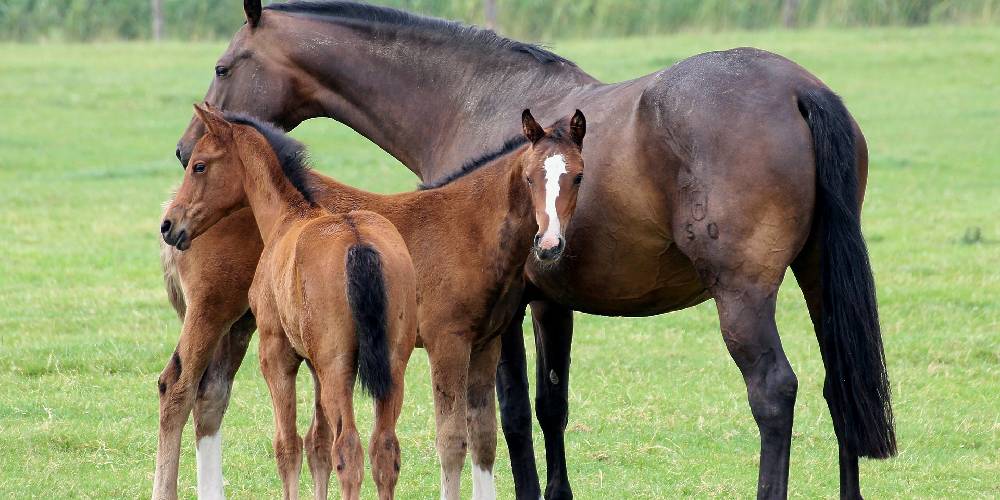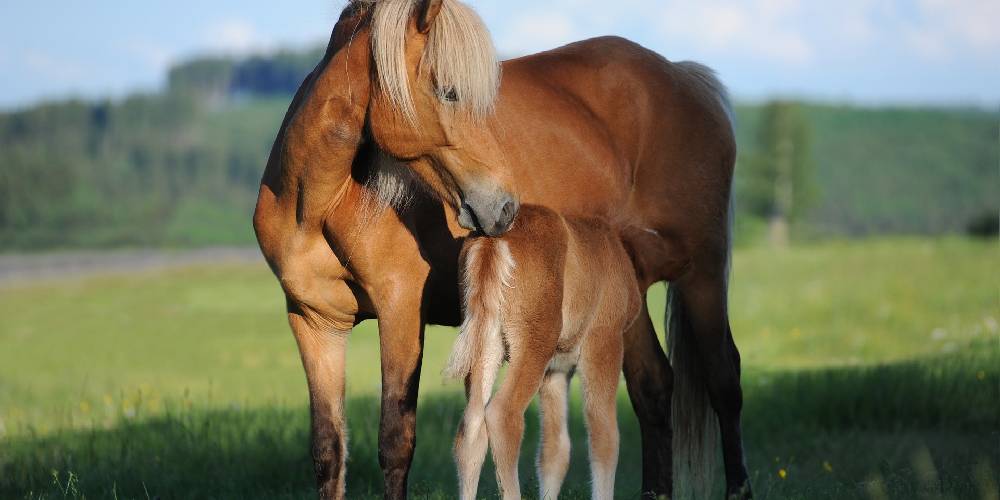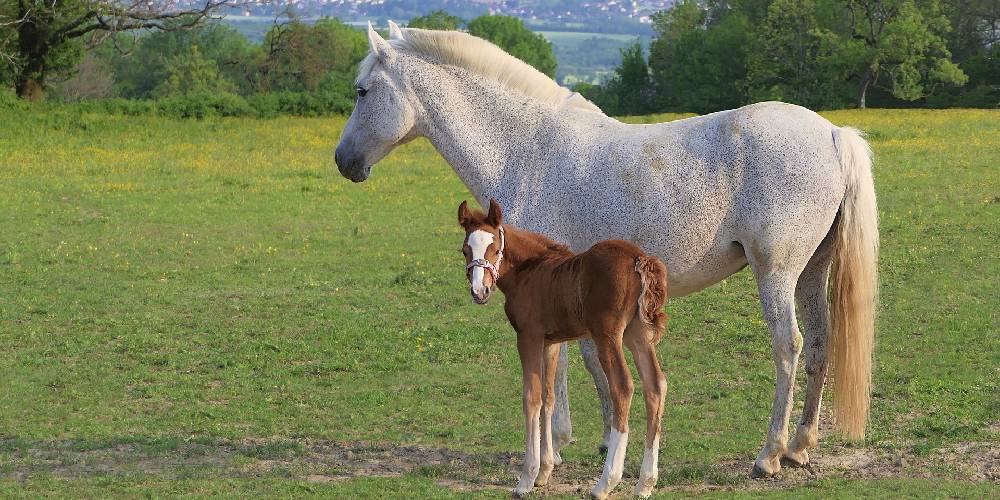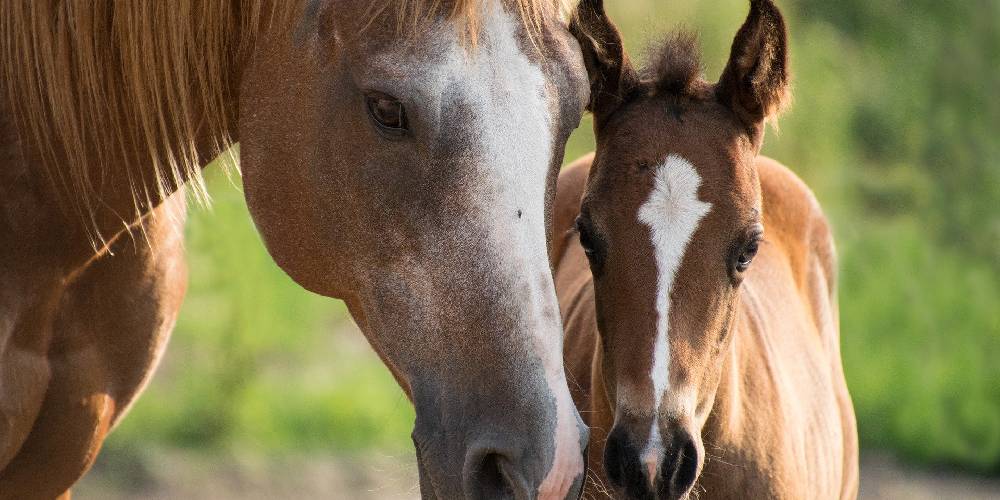Horses are pregnant for around 11 months and typically foal in the spring and summer months. Breeders aim to have foals born as close to January first as possible as this is the official birthday for horses, especially Thoroughbred racehorses.
Why Aren’t Horses Born In The Fall & Winter Months?

In the wild, breeding season for most animals falls typically in fall and winter, but with horses it’s different. Horses have a longer gestation period than other animals which lasts 11 months. Horses will usually breed in spring and summer as their gestation period lasts nearly a year. This is so their offspring will be born in the warmer months rather than the freezing winter months.
Horses have their babies usually in the spring and summer to let them get stronger and grow up a bit before they are plunged into a cold freezing winter.
How Do Veterinarians Examine A Fetus?
When the fetus is first developing, veterinarians usually just use an ultrasound machine to examine the small fetus. Ultrasounds are usually used in horses to determine whether or not a horse is in fact pregnant and to detect a heart beat in the fetus.
As the horse gets further along in the pregnancy, veterinarians may use a more hands-on technique to examine the developing foal. Rectal palpations are basically when a veterinarian uses a glove to keep their arm clean as they reach back into a horse’s body. When a fetus is big enough, veterinarians can feel the developing foal by performing rectal palpations. Rectal palpations are used when examining a foal for the position in the uterus, health, deformities, and size.
When A Horse Is Born, How Long Will It Rely On Its Mother?

Horses, when born, rely on their mothers from birth to several months in age. Horses are typically separated from their mothers around the age of seven months. By this point in their life, they no longer rely on their mothers for their food and they have switched completely over from relying on her milk to grazing as an adult horse would.
By the time a foal is two months old, the milk from their mother is not enough to support and sustain them anymore. At this point in their life, the foal begins the gradual switch to living off of the grass and vegetation rather than milk.
How Do Horses Get Pregnant?
Live Cover
Breeding by live cover is essentially the most natural way to breed a horse. Live cover is done where the stallion is brought to a mare in heat and he mounts her and mates with her in person.
Live cover is the only way horses mate in the wild and this is the most natural way for a horse to reproduce.
Thoroughbred racehorses are only allowed to be bred through a live cover. This makes some Thoroughbreds extremely inbred as the stallion availability is limited. If someone in America wants to breed their mare to a stallion in Britain, they need to ship their mare overseas.
Sometimes when breeding horses through live cover, a mare might reject the stallion making it difficult, if not impossible, to breed the two. In cases like this, breeding hobbles are required so the mare can’t lash out at the stallion.
Live cover breeding requires handlers to keep control of the horses at all times. Sometimes, when doing a live cover, the stallion goes crazy and can lose his composure and try to get to the mare with everything he’s got. This can potentially endanger the handlers and people aiding in the breeding process.
Artificial Insemination
Artificial insemination is one of the more popular forms of horse breeding and impregnating seen. Artificial insemination is seen in nearly every single discipline and style of riding other than Thoroughbred racing.
The main benefit to the use of artificial insemination is that a stallion’s bloodlines can be reached and accessed to that much more people and horses. This reduces the chances and probability of inbreeding.
Another benefit to the use of artificial insemination and impregnation of horses is so no injury comes to the mare or stallion that may be seen in a live cover. In live cover breeding, sometimes the mare doesn’t want to mate with the stallion and she may lash out and kick at him. Other times, the stallion might bite at the mare’s neck when he mounts her, potentially injuring the mare.
When Does The Fetus Have A Heartbeat?

About two weeks or fourteen days days after the mare has been bred, the fetus should be visible in an ultrasound. It is at this time that the veterinarian will check to see if the mare will be expecting twins as well as to confirm that the horse is truly pregnant. Sometimes, mares need to mate more than once to become pregnant and take the semen.
Between the twenty-sixth and thirtieth day of pregnancy, a heartbeat should be visible under ultrasound. It is around this time where the veterinarian will confirm a horse’s pregnancy and officially determine whether there are two living twins or not if a twin is present.
How Do Horses Respond To Being Pregnant?
Horses respond in many different ways to pregnancy, but the average mare will usually calm down significantly in response to carrying a baby. Mares, when pregnant, no longer will go into a monthly heat cycle. It is during this heat cycle that a mare is the moodiest and temperamental and pregnancy removes this natural cycle from a horse’s monthly schedule.
Other than being calm and mellow during most of their pregnancy, horses will also respond to stallions differently. A pregnant mare will strongly reject a stallion that is trying to approach and mate with her as she is already carrying a foal.
The new rush of hormones that these mares experience is the main cause for their temperament change. Sometimes, even after a mare has given birth, they will remain much calmer and mellow after they had a foal than before. Because of this, people will often breed their mares to try to get them to mellow out and become more manageable.

